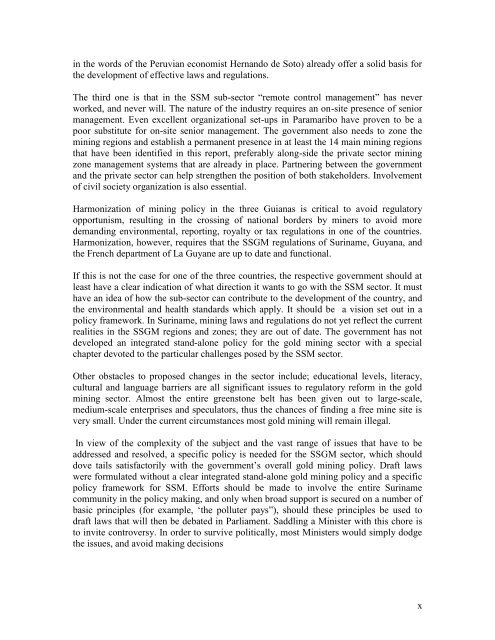SITUATION ANALYSIS OF THE SMALL-SCALE GOLD ... - WWF
SITUATION ANALYSIS OF THE SMALL-SCALE GOLD ... - WWF
SITUATION ANALYSIS OF THE SMALL-SCALE GOLD ... - WWF
You also want an ePaper? Increase the reach of your titles
YUMPU automatically turns print PDFs into web optimized ePapers that Google loves.
in the words of the Peruvian economist Hernando de Soto) already offer a solid basis for<br />
the development of effective laws and regulations.<br />
The third one is that in the SSM sub-sector “remote control management” has never<br />
worked, and never will. The nature of the industry requires an on-site presence of senior<br />
management. Even excellent organizational set-ups in Paramaribo have proven to be a<br />
poor substitute for on-site senior management. The government also needs to zone the<br />
mining regions and establish a permanent presence in at least the 14 main mining regions<br />
that have been identified in this report, preferably along-side the private sector mining<br />
zone management systems that are already in place. Partnering between the government<br />
and the private sector can help strengthen the position of both stakeholders. Involvement<br />
of civil society organization is also essential.<br />
Harmonization of mining policy in the three Guianas is critical to avoid regulatory<br />
opportunism, resulting in the crossing of national borders by miners to avoid more<br />
demanding environmental, reporting, royalty or tax regulations in one of the countries.<br />
Harmonization, however, requires that the SSGM regulations of Suriname, Guyana, and<br />
the French department of La Guyane are up to date and functional.<br />
If this is not the case for one of the three countries, the respective government should at<br />
least have a clear indication of what direction it wants to go with the SSM sector. It must<br />
have an idea of how the sub-sector can contribute to the development of the country, and<br />
the environmental and health standards which apply. It should be a vision set out in a<br />
policy framework. In Suriname, mining laws and regulations do not yet reflect the current<br />
realities in the SSGM regions and zones; they are out of date. The government has not<br />
developed an integrated stand-alone policy for the gold mining sector with a special<br />
chapter devoted to the particular challenges posed by the SSM sector.<br />
Other obstacles to proposed changes in the sector include; educational levels, literacy,<br />
cultural and language barriers are all significant issues to regulatory reform in the gold<br />
mining sector. Almost the entire greenstone belt has been given out to large-scale,<br />
medium-scale enterprises and speculators, thus the chances of finding a free mine site is<br />
very small. Under the current circumstances most gold mining will remain illegal.<br />
In view of the complexity of the subject and the vast range of issues that have to be<br />
addressed and resolved, a specific policy is needed for the SSGM sector, which should<br />
dove tails satisfactorily with the government‟s overall gold mining policy. Draft laws<br />
were formulated without a clear integrated stand-alone gold mining policy and a specific<br />
policy framework for SSM. Efforts should be made to involve the entire Suriname<br />
community in the policy making, and only when broad support is secured on a number of<br />
basic principles (for example, „the polluter pays”), should these principles be used to<br />
draft laws that will then be debated in Parliament. Saddling a Minister with this chore is<br />
to invite controversy. In order to survive politically, most Ministers would simply dodge<br />
the issues, and avoid making decisions<br />
x
















